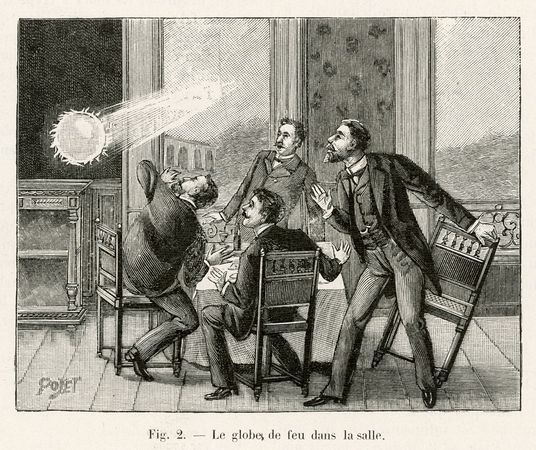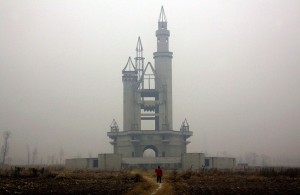Ball Lightning: A Mystery Unsolved (Videos)
Ball lightning is a phenomena that has been reported hundreds of times throughout recorded history, but we really aren’t any nearer to finding out what it is, what causes it or why it happens. For those that haven’t come across it, in a nutshell, it’s a hot, shiny ball of something. That’s not very precise, but that’s all we’ve got.
The size of ball lightning varies from a few inches to a few feet across, sometimes it moves up and down, sometimes forward and back. On occasion, the balls are attracted to buildings or structures, sometimes repelled by them; sometimes it moves with the wind, or sometimes against.
Some reports have ball lightning moving through solid items effortlessly, whilst other witnesses have it destroying objects on impact. It’s quite possible that ball lightning is a group of phenomena rather than just one single type of event.
Some things about ball lightning are fairly consistent, though: it normally occurs around the time of a thunderstorm, heat is generally involved in some way, and there’s often a smell of sulphur before, during or after the event.
Ball Lightning Examples
Ball lightning was reported as far back as December 1596 in John Stowe’s annals. Here’s what went down during a sermon in Wells, Somerset:
There entered in at the west window of the church a dark unproportioned thing about the bigness of a football, and went along the wall on the pulpit side; and suddenly it seemed to break with no less sound than if a hundred cannons had been discharged at once; and therewithal came a most violent storm and tempest of lightning and thunder as if the church had been full of fire.
No one was killed but a few were knocked off their feet.
During the Great Thunderstorm of Widecombe-in-the-moor in 1638, four were killed and about 60 injured when a ball of lightning careered into the church and almost completely destroyed it. You can imagine how the phenomena was attributed at the time, stinking of sulphur and attacking a church. As far as they were concerned, Satan was on the rampage.
The priest, George Lyde, was unscathed, but his wife “had her ruff and the linen next her body, and her body, burnt in a very pitiful manner.” One poor chap – Robert Mead – struck a pillar so hard that it left an indentation; his skull was shattered, and his brain hurled to the ground. “Master Hill a Gentleman of good account in the Parish” was thrown so violently against a wall that he died later that night; oddly, his son, sitting next to him, was unhurt.
Leaping forward to July 2011 there was another incident in Liberec, Czech Republic, where a ball flew through the control room of a local emergency service, bounced about a bit, made all the computers freeze, knocked out communications, then promptly disappeared leaving one broken monitor and the smell of burning electrics.
Ball Lightning Theories
So what causes these things? Obviously they’re difficult to study, if you don’t know where or when something is going to happen it’s pretty darned tricky to find anything out about it. Theories abound though, there’s plenty of conjecture in the field of ball lightning. Here’s a small slice of it:
- Microwave cavity hypothesis – driven by microwave radiation guided to the ball along ionized air from clouds
- Soliton Hypothesis – a type of detached St Elmo’s Fire
- Vaporized silicon hypothesis – lightning strikes the ground and vaporizes the silica within it, somehow producing silica vapour which cools and condenses into floating aerosol
- Hydrodynamic vortex ring anti-symmetry
- Nanobattery hypothesis
- Buoyant plasma hypothesis
- Spinning electric dipole hypothesis
The list goes on.
Ball Lightning In The Lab
The first step to understanding these weird things would be to produce ball lightning in the lab. There are people trying to do this in a number of ways, but whether the results are an accurate representation of ball lightning or not is impossible to say without having tested a “real” one in the field.
Here’s a video showing you how to make something similar using candles and a household microwave:
The picture below is from a water discharge experiment which involves discharging a high-voltage capacitor in a tank of water:
Another way of creating ball lightning-like behaviour in the lab is achieved using silicon. This method involves “evaporating pure silicon with an electric arc”.
A more recent attempt by Dr Mike Lyndsay at Colorado’s US Air Force Academy was in the news in August 2013. The scientists designed a way to make clouds of plasma hang around for longer than they normally would in order to study them.
They produce clouds of plasma lasting for about half a second above a charged electrolyte solution. Dr Lyndsay is pleased with the results but still admits that it is impossible to know if it really is ball lightning or not:
Video Footage Of Ball Lightning
Real life footage of ball lightning is scant, but there are some pretty good examples out there. In this first clip, ignore the flecks in front of the camera initially, they’re from the camp fire. But at about 28 seconds in you get a good look, in centre of the screen, of what may well be ball lightning:
This next clip came online in July 2015. It was taken at Sioux Fall, South Dakota. Skip to around 37 seconds:
Here’s another from Siberia in August 2015:
This next clip comes from Saudi Arabia. Pulses of white light move along electricity lines shortly after they were struck by lightning. Pretty darned epic:
Here’s one from the UK. Skip to 1:30.
New Orlean 2012:
Switzerland, August 2015:
Russia, 2013:
So the mystery lives on, we’re learning how to generate things that at least look like ball lightning. Now we have to find a way of measuring, or at least tracking down the real thing in the field to see what they’re actually made of.
It may well be a while before the case is closed on this mysterious beast. Some even believe that reports of ball lightning are a psychological phenomenon, just to add another twist to an already overly convoluted tale. I must admit, the videos above have convinced me that ball lightning is a physical phenomenon.
MORE WEATHER STUFF:
HOW TO PREDICT THE WEATHER WITH CLOUDS
ROY SULLIVAN THE MAN WHO WAS HIT 7 TIMES




















